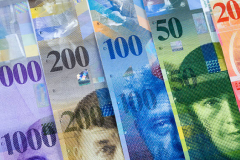In January 2015, the Swiss National Bank (SNB) unexpectedly removed the de facto peg of the franc to the euro. The move was welcomed by free-market economists. It was deemed that the short-run adjustments to the Swiss economy triggered by the appreciation of the franc were preferable to the macro-economic stability risks posed by the inflation imported from the euro area during the peg. Yet, it would have been difficult to anticipate that the SNB’s interventionist monetary policy would continue aggressively also after the peg.
Let’s give some background. Since the onset of the Great Recession, investors flocked into the Swiss franc as a safe haven asset. They feared that ultra-loose monetary and fiscal policies would damage the quality of most other major currencies. Significant net financial inflows to the tune of CHF 460bn (70% of 2016 GDP) made their way into the alpine economy as a repatriation of bank deposits. Simultaneously, large current account surpluses amounting to about CHF 600bn were recorded. More than half of the external inflows were purchased by the SNB in order to limit the appreciation of the franc and help exporters. It led to a vast increase in foreign reserve assets of about CHF 690 bn. The SNB also reduced aggressively its interest rates to negative levels, surpassing both the Fed and the ECB.
The extremely large scale of SNB monetary interventions, not only during, but also outside of the peg, has probably been less obvious to most observers. Helped by the negative interest rate differential, the monthly average of external financial inflows dropped into half during the peg (left chart below). Nevertheless, the SNB’s FX purchases – measured as the change in foreign reserves – absorbed almost fully the external inflows. After the peg, SNB’s FX purchases declined to about 60% of foreign inflows, but the average monthly increase in reserves declined by only 20% in absolute terms vs. the peg. This shows that the unpegging of the franc was followed by heavy SNB monetary interventions. At the same time the domestic liquidity absorbed by the SNB increased significantly after the unpegging of the franc.











Leave A Comment